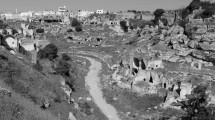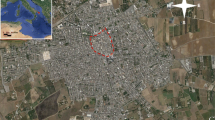Abstract
This article presents a multidisciplinary approach to the assessment of slope deformation at the Lower Hodruša mining water reservoir, which is part of a UNESCO cultural heritage site. The multidisciplinary approach was used to develop remedial measures. The Lower Hodruša mining water reservoir is situated in the Hodruša-Hámre municipality near Banská Štiavnica in the central part of Slovakia. The first mention of the construction of the reservoir is from 1743, and according to historical records, there were problems with slope stability already at that time. Nowadays, to increase the volume of water available for technical operations in the Hodruša valley, the decision was made to increase the dam’s output capacity. Slope movements were first detected while the reservoir was being drained. A part of the left shore 50 to 150 m from the dam crest moved, damaging adjacent buildings. The Hodruša-Hámre municipal authorities declared an emergency on 24 August 2015 because of the appearance of cracks in the asphalt surface of the national road and its subsidence. The main discontinuity conformed approximately to the contours of the known landslide area on the south side of the reservoir. The significant deformations involving the 0.20-m subsidence of the service road were reported during heavy rainfall in October 2014. A range of geoscientific disciplines was used to develop a detailed description of the landslide area and to determine the cause of the slope deformation. The depth and course of the shear surface were measured using boreholes and geophysical methods; the historic development of the landslide was analysed using dendrochronological measurements; and the present horizontal and vertical movement of the landslide over one and half years was determined using geodetic monitoring based on a network of stabilised points and inclinometer measurements.














Similar content being viewed by others
References
Alestalo J (1971) Dendrochronological interpretation of geomorphic processes. Fennia 105:1–139
Auken E, Pellerin L, Christensen NB, Sørensen K (2006) A survey of current trends in near-surface electrical and electromagnetic methods. Geophysics 71(5):G249–G260
Ceylan A, Karabork H, Ekozoglu I (2011) An analysis of bathymetric changes in Altinapa reservoir. Carpathian J Earth Environ Sci 6(2):15–24
Corona C, Lopez Saez J, Stoffel M (2014) Defining optimal sample size, sampling design and thresholds for dendrogeomorphic landslide sampling. Quat Geochronol 22:72–84
Čech V, Krokusová J (2017) Utilisation of environmentally degraded area by mining activity: a case study of Slovinky tailing impoundment in Slovakia. Acta Montanistica Slovaca 22(2):180–192
Dahlin T, Zhou B (2004) A numerical comparison of 2D resistivity imaging with 10 electrode arrays. Geophys Prospect 52(5):379–398
Dahlin T (2001) The development of DC resistivity imaging techniques. Comput Geosci 27(9):1019–1029
Floris M, Bozzano F (2008) Evaluation of landslide reactivation: a modified rainfall threshold model based on historical records of rainfall and landslides. Geomorphology 94:40–57
Fuska J, Kubinský D, Weis K, Lackóová L, Pokrývková L, Leitmanová M, Panagopoulos T (2017) Area-storage capacity curve of historic artificial water reservoir Ottergrund, Slovakia—assessment of the historical data with the use of GIS. J Ecol Eng Warszawa Polish Soc Ecol Eng (PTIE) 18(1):49–57
Gomolčák M (2015) Remedial works on active landslide Hodruša Hámre. Final report. GEOKONTAKT Ltd., Košice
Griffiths DH, Barker RD (1993) Two-dimensional resistivity imaging and modelling in areas of complex geology. J Appl Geophys 29(3):211–226
Choiński A, Ptak M (2009) Lake infill as the main factor leading to lake’s disappearance. Pol J Environ Stud 18(3):347–352
Janský B, Schulte A, Česák J, Rios Escobar V (2010) The Mladotice Lake, western Czechia: the unique genesis and evolution of the lake basin. Geografie Praha Czech Geogr Soc 115(3):247–265
Kašiarová E (2003) Lower Hodruša water reservoir, Štiavnické bane. Newsletter BEVEX-Mining research Prievidza, vol. 2–4
Kasza R (2016) Monitoring of the reactivated surface landslide in the area of Dolné Hodrušské Lake. Bachelors thesis, Matej Bel University, Faculty of Natural Sciences, Department of Geography and Geology, 48 p
Konečný V, Lexa J, Halouzka R, Hók J, Vozár J, Dublan L, Nagy A, Šimon L, Havrila M, Stolár M, Polák M, Vozár J, Pristaš J (1998) Geological map of Štiavnické vrchy Mts. and Pohronský Inovec at a scale 1:50 000. GSSR, Bratislava
Kubinský D, Lehotský M, Weis K (2014a) Changes in bathymetry and land cover of riparian zone of an old artificial water reservoir Veľký Kolpašký. Carpathian J Earth Environ Sci 9(1):171–178
Kubinský D, Weis K, Fuska J, Lehotský M, Petrovič F (2014b) Changes in retention characteristics of 9 historical artificial water reservoirs near Banská Štiavnica, Slovakia. Open Geosciences: De Gruyter Open Ltd 7(1):880–887
Ministry of Environment of the Slovac Republic (ed) (2002) Landscape atlas of the Slovak Republic, 1st edn. Slovak Enviromental Agency, Banská Bystrica 344 p
Lexa J (2016) Specialized geological map of Rozália Mine (Hodruša-Hámre), M1: 5000
Loke MH, Acworth I, Dahlin T (2003) A comparison of smooth and blocky inversion methods in 2D electrical imaging surveys. Explor Geophys 34(3):182–187
Lopez-Saez J, Corona C, Stoffel M, Astrade L, Berger F, Malet JP (2012) Dendrogeomorphic reconstruction of past landslide reactivation with seasonal precision: Bois Noir landslide, southern French Alps. Landslides 9:189–203
Migoń P, Kacprzak A, Malik I, Kasprzak M, Owczarek P, Wistuba M, Pánek T (2014) Geomorphological, pedological and dendrochronological signatures of a relict landslide terrain, Mt Garbatka (Kamienne Mts), SW Poland. Geomorphology 219:213–231
Nemčok A (1982) Landslides in Slovak Carpathians. Veda, Bratislava, p 319 (In Slovak)
Pánek T, Šilhán K, Tábořík P, Hradecký J, Smolková V, Lenárt J, Brázdil R, Kašičková L, Pazdur A (2011) Catastrophic slope failure and its precedings: case of the May 2010 Girová Mountain long-runout rockslide (Czech Republic). Geomorphology 130:352–364
Petley DN, Allison RJ (1997) The mechanics of deep-seated landslides. Earth Surf Process Landf 22:747–758
Prokešová R, Kardoš M, Medveďová A (2010) Landslide dynamics from high-resolution aerial photographs: a case study from the Western Carpathians, Slovakia. Geomorphology 115:90–101
Prokešová R, Medveďová A, Tábořík P, Snopková Z (2013) Towards hydrological triggering mechanisms of large deep-seated landslides. Landslides 10:239–254
Shroder JF (1978) Dendrogeomorphological analysis of mass movement on Table Cliffs Plateau, Utah. Quat Res 9:168–185
Smolková V, Pánek T, Hradecký J (2009) Holocene sedimentation dynamics and average catchment denudation acquired from the sedimentary basins of the landslide-dammed lakes in the Flysch Carpathians. In: Geomorfologicky sbornik 8: Sbornik abstraktů. Zapadočeska univerzita v Plzni, Ustav struktury a mechaniky hornin AV ČR, v. v. i., Česka asociace geomorfologů, p 52
Stoffel M, Bollschweiler M (2008) Tree-ring analysis in natural hazards research—an overview. Nat Hazards Earth Syst Sci 8:187–202
Stoffel M, Butler DR, Corona C (2013) Mass movements and tree rings: a guide to dendrogeomorphic field sampling and dating. Geomorphology 200:106–120
Šilhán K (2012) Dendrogeomorphological analysis of the evolution of slope processes on flysch rocks (Vsetínské vrchy Mts; Czech Republic). Carpathian J Earth Environ Sci 7:39–49
Šilhán K (2017) Evaluation of growth disturbances of Picea abies (L.) Karst. to disturbances caused by landslide movements. Geomorphology 276:51–58
Šilhán K, Prokešová R, Medveďová A, Tichavský R (2016) The effectiveness of dendrogeomorphic methods for reconstruction of past spatio-temporal landslide behaviour. Catena 147:325–333
VIAS (2005) Vienna Institute of Archaeological Science: Time Table, Installation and instruction manual. Ver. 2.1, Vienna
Vonšáková D (2017) Virtual reconstruction of the extinct historic water reservoir and the possibility of its use in geotourism, Master thesis, University of Matej Bel in Banska Bystrica. Faculty of Natural Sciences, Department of Geography and Geology, 74 p
Weis K, Kubinský D (2014) Analysis of changes in the volume of water in the Halčianske reservoir caused by erosion as a basis for watershed management. Geografie Praha, Czech Geogr Soc 119(2):126–144
Funding
This work was partially supported by the Slovak Research and Development Agency under contracts no. APVV-0129-12, APVV-16-0146 and by the Scientific Grant Agency of the Ministry of Education, Science, Research and Sport of the Slovak Republic and the Slovak Academy of Sciences (VEGA) within the project no. 1/0559/17 and the Operational Programme Research and Development funded by the ERDF grant no. ITMS-26210120024, Restoration and building of infrastructure for ecological and environmental research at the Matej Bel University of Banská Bystrica.
Author information
Authors and Affiliations
Corresponding author
Rights and permissions
About this article
Cite this article
Bednarik, M., Putiška, R., Dostál, I. et al. Multidisciplinary research of landslide at UNESCO site of Lower Hodruša mining water reservoir. Landslides 15, 1233–1251 (2018). https://doi.org/10.1007/s10346-018-0973-5
Received:
Accepted:
Published:
Issue Date:
DOI: https://doi.org/10.1007/s10346-018-0973-5




